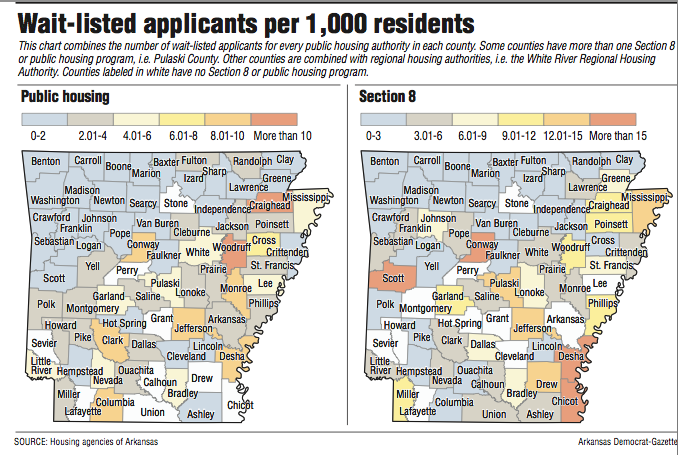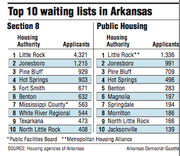Central Arkansas' high demand for housing assistance was writ large in the spring when Pulaski County opened its waiting list for Section 8 rental-assistance vouchers.
The county allows sign-ups only once, sometimes twice, a year. The date and location for sign-ups was advertised on social media and in newspapers in the region. On sign-up day in April, starting at 8 a.m., the county sought to add about 150 applicants to its housing assistance waiting list, which is capped at 250.
"We tell them that you can't line up before 7 o'clock, because people would start showing up at 3 in the morning," said Fred Love, the county's director of community services.
About 800 people showed up for what turned into an unruly Black Friday-esque spectacle. Little Rock police and county deputies were called. By 9 a.m., law enforcement officials ordered the county to shut down the event.
"People just went belligerent. They were mad. They were cussing, upset, fighting in line," Love said. "It's sad, because we don't actually have enough money to take care of the need out there."
Across the nation, increased demand and the dwindling supply of low-cost housing have put pressure on federally subsidized housing programs. And while demand for Section 8 rental assistance vouchers and public housing units have increased, the U.S. Department of Housing and Urban Development funding has seen deep congressional budget cuts.
Since 2010, when the federal housing agency's budget crested at $46.3 billion, trims have cut into HUD's housing assistance programs, which are administered at the local level.
During the U.S. budget sequestration in 2013, the agency's budget was cut by 15.4 percent, forcing housing agencies to reduce the number of families getting rental assistance vouchers by 100,000, according to the Center on Budget and Policy Priorities.
By 2016, Congress found funding to restore those vouchers, but the agency's budget is still 6.1 percent below what it was in 2010.
"In light of the fact that rents across the country are going up, and that the housing market is very hot right now, the need for affordable housing is very high," said Patricia Campbell, a public affairs officer with HUD. "Housing authorities have aging stock, and the congressional funding they've been receiving over the years continues to decline."
The lack of low-cost housing has been particularly hard on low-wage earners in cities like San Francisco, New York, Washington and Los Angeles, but the problem isn't confined to those high-rent cities.
An Arkansas Democrat-Gazette survey of all roughly 130 public housing agencies in the state found that more than 73,000 Arkansans are living in federally-assisted housing, with roughly two-thirds of those receiving Section 8 vouchers. According to the latest census data, that's 2.5 percent of the state's total population.
And more than 25,000 Arkansans are on waiting lists for either public housing units or Section 8 vouchers.
Desha County, with a population of 12,505, has the highest demand for Section 8 vouchers with 31 people on waiting lists per 1,000 residents. Conway, Scott and Chicot counties follow, each with 15.3 people on voucher waiting lists per 1,000 residents.
Per capita demand for public housing units -- housing built with federal dollars -- is highest in Woodruff County, where 13 people per 1,000 residents are on waiting lists, followed by Craighead County, where 10 people per 1,000 residents are on waiting lists.
Between the Little Rock Metropolitan Housing Alliance, the North Little Rock Housing Authority, the Jacksonville Housing Authority, and the Pulaski County Housing Program -- some of the larger housing agencies in the state -- Pulaski County has the highest number of federally assisted residents.
Love, who oversees the Pulaski County Housing Program, described the delicate balancing act his division goes through to house as many families as possible with a limited budget.
Each voucher recipient gets a monthly subsidy that's paid to landlords and is hinged on the recipient's income. If the recipient loses his job, the subsidy amount increases.
And, the program must maintain a financial cushion so that in the event of an economic downtown, it can continue to support voucher recipients, numbers of whom could lose their jobs roughly at the same time. Although the county is authorized by HUD to issue up to 325 vouchers, it can fund only 287 in order to maintain that cushion.
"We have to do what we can and budget so that we won't run into a deficit. Because when you run into a deficit, guess what, the last five families you put on, they have to come off," Love said. "How do you tell five families, 'we have to take your housing'?"
Since 2010, Love's program has experienced a 30 percent funding cut from HUD, according to federal data.
"You try to spend what you're comfortable with in order to not tip the scale. But you still have to house everybody that you can," he said.
In the northeast corner of the state, the Public Facilities Board in Mississippi County, where unemployment rates have lingered at 7.2 percent, has issued 525 vouchers. Its waiting list is long, at 563 applicants, a queue that could leave a family waiting more than five years for help, officials said.
The board's director, David Hamilton, said he wishes he could issue all 640 vouchers authorized to his agency by HUD. The last time his organization was able to do that, he said, was in 2006. Today, his organization faces budget cuts and high demand from the lingering effects of the economic recession in the Delta.
"When families move out, it seems like HUD takes advantage and drops our funding instead of keeping our funding up so we can re-lease back up," he said.
"People have this perception that public housing is not needed out here [in rural areas] as in the larger cities," Hamilton said.
Lower in the Delta, in Desha County, the McGehee Housing Authority serves a population of 4,200. And like Mississippi County, the need for public assistance remains high.
"If they cut out the food stamp program, then the grocery stores would close, a lot of the businesses would have to close," said McGehee authority's Executive Director Kenny Gober.
The agency has 58 units of public housing with 108 applicants on the waiting list, and 341 Section 8 vouchers with 386 applicants in the waiting list. The authority prioritizes its vouchers list, serving the elderly, the disabled and employed applicants first.
"We truly believe that if you want work, you can find a job," Gober said.
In Greene County, the Paragould Housing Authority's operating budget has dropped by 20 percent since 2010. Its capital improvement funds have shrunk by 20 percent and its Section 8 voucher program by 10 percent, according to data provided by HUD.
But it is the slow demise of Paragould's Section 202 program, which supplied housing assistance to the elderly beginning in 2004, that disappoints Executive Director David Lange the most.
"That was a great program," Lange said. "But that money for the most part is almost gone. To me, that made the biggest impact in our community."
"The number of needs are growing in our situation, especially in the elderly population," he said. "I think we're hitting the middle of the baby boomers, and they're hitting their early 60s. It's not that many of them didn't work hard all their life, they just may be limited to Social Security. It's hard for an elderly person to survive on Social Security alone."
Also wrestling with cuts is the Pine Bluff Housing Authority, where no new public housing projects have been constructed since the 1980s, authority Director Jeannie Epperson said. Reduced funding has prevented the authority from issuing any new vouchers since March.
In Northwest Arkansas, where employment rates are the strongest in the state, public housing agencies face a different set of problems. Waiting lists are shorter than in other regions of the state, but housing availability is limited, which restricts tenants' options, even if they've obtained vouchers.
"One of the problems our voucher-holders have is finding units that will pass inspection," said Neal Gibson, executive director of the Northwest Regional Housing Authority, whose territory covers seven counties between Baxter County and Madison County.
Finding landlords in the area who will accept Section 8 subsidies is another problem, Gibson said.
President Barack Obama has proposed some changes in his 2017 budget.
The budget requests an overall 3.5 percent increase in what Congress provided to HUD in 2016. It also includes an "ambitious, groundbreaking" initiative to expand voucher programs for homeless families that have children, according to an analysis issued by the Center on Budget and Policy Priorities.
The proposal designates $11 billion for housing assistance for those families, which is projected to help 550,000 families over 10 years. But it also calls for a decrease in funds allocated for new construction of public housing facilities.
"There's a need for affordable housing all over the country, even in the communities you would consider prosperous," said Wanda Merrit, the director of HUD's field office in Little Rock. "You're always going to have some element of folks that need some assistance."
Metro on 10/30/2016


